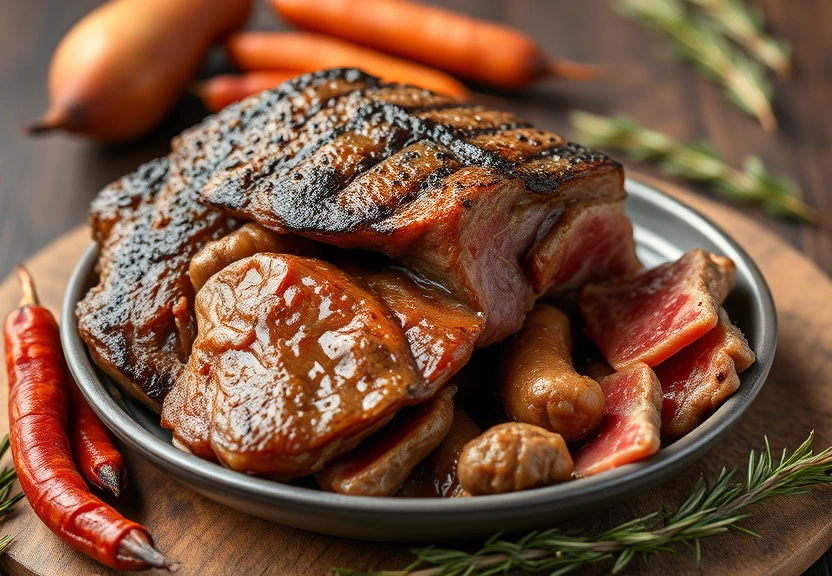Neandertals: New Theory Reveals Consumption of Meat with Larvae, Challenging Myths About Their Diet
For decades, the image of Neandertals has been painted with broad strokes of “hyper-carnivorism.” These ancient hominids, often depicted as fierce hunters, were believed to primarily consume animal protein. However, a recent study challenges this long-standing notion, introducing evidence that Neandertals also incorporated larvae into their diet, indicating a more complex nutritional strategy than previously understood. This article delves into the findings of this groundbreaking research, shedding light on the true dietary habits of Neandertals and what it means for our understanding of human evolution.

The implications of these findings extend beyond just the Neandertals themselves. As we explore their diet, we uncover insights into their survival strategies, social behaviors, and adaptability, which can inform our understanding of human diets today. With the new evidence of larvae consumption, we are prompted to rethink the simplistic categorization of ancient diets and to recognize the nuances involved in the survival of early human relatives.
The Misconception of Hyper-Carnivorism
Historically, Neandertals have been characterized as hyper-carnivorous, primarily based on archaeological findings that indicated a heavy reliance on large game. This portrayal suggested that they were formidable hunters who thrived on a diet consisting almost entirely of meat. However, the new research reveals that this perspective may have overlooked the diversity in their dietary practices.
Understanding Hyper-Carnivorism
Hyper-carnivorism refers to a diet that consists of 70% or more animal-derived food sources. While it is true that Neandertals consumed significant amounts of meat, particularly from large mammals like woolly mammoths and reindeer, this new study suggests that their diet was not limited to just animal protein. The inclusion of larvae and other nutrient sources points to a more flexible and opportunistic feeding strategy.
The New Study: Evidence of Larvae Consumption
The recent research, which combines paleoanthropological evidence with advanced analytical techniques, reveals that Neandertals consumed larvae along with their regular diet of meat. This discovery was made possible by examining ancient feces and dental calculus, which preserved traces of organic materials.
Methodology of the Research
The researchers employed a combination of methods, including:
- Paleoecological Analysis: Studying the environmental context in which Neandertals lived to understand the availability of different food sources.
- Zooarchaeology: Analyzing animal remains found at Neandertal sites to ascertain the types of animals hunted.
- Microscopic Analysis: Examining dental calculus and coprolites (fossilized feces) to identify preserved organic materials, including larvae.
Implications of Larvae Consumption on Neandertal Diet
The revelation that Neandertals consumed larvae has significant implications for our understanding of their diet and survival strategies. This flexibility in diet may have been a critical adaptation to the changing climates and environments they faced during the last Ice Age.
Dietary Flexibility and Survival
By consuming larvae, Neandertals likely increased their access to essential nutrients, particularly during periods when large game was scarce. This dietary flexibility may have allowed them to survive in diverse habitats and adapt to various ecological conditions. Furthermore, it illustrates a level of ingenuity and resourcefulness that challenges the stereotype of Neandertals as primitive beings.
Broader Insights into Human Evolution
The findings about Neandertal diets also contribute to the broader narrative of human evolution. Understanding Neandertals’ dietary strategies can help us draw parallels with modern human dietary practices and adaptability.
Lessons for Contemporary Diets
The exploration of ancient diets encourages modern humans to consider the value of dietary diversity. Just as Neandertals incorporated various food sources to thrive, contemporary diets can benefit from a broader range of nutrients. This reflection on ancient practices may inform current discussions about nutrition, food security, and sustainable eating.
Key Points to Remember
- The long-standing view of Neandertals as hyper-carnivorous is being challenged by new evidence.
- Recent studies indicate that Neandertals consumed not only meat but also larvae, showcasing dietary flexibility.
- The research methodology involved paleoecological analysis, zooarchaeology, and microscopic analysis of dental calculus and coprolites.
- Incorporating larvae into their diets may have provided essential nutrients and helped Neandertals survive in varying environmental conditions.
- Understanding Neandertal diets can offer insights into human dietary evolution and contemporary nutrition strategies.
Frequently Asked Questions (FAQ)
1. What does the new research say about Neandertal diets?
The new research reveals that Neandertals consumed larvae in addition to meat, challenging the previous notion that they were exclusively hyper-carnivorous.
2. How was the evidence for larvae consumption gathered?
Researchers utilized paleoecological analysis, zooarchaeology, and microscopic examinations of dental calculus and ancient feces to gather evidence of larvae consumption.
3. What are the implications of this research for our understanding of Neandertals?
The findings suggest that Neandertals had a more diverse and flexible diet than previously thought, which may have contributed to their survival in diverse environments.
4. How does this research connect to modern dietary practices?
This research highlights the importance of dietary diversity, suggesting that modern diets could benefit from incorporating a wider range of nutrients similar to the adaptive strategies of Neandertals.
5. What is the significance of challenging the hyper-carnivorism stereotype?
Challenging the hyper-carnivorism stereotype allows for a more nuanced understanding of Neandertal behavior, adaptability, and survival strategies, ultimately enriching the narrative of human evolution.
Conclusion
The recent findings regarding the Neandertal diet represent a significant shift in our understanding of these ancient hominids. By uncovering evidence of larvae consumption, researchers have painted a more complex picture of Neandertal nutrition that emphasizes adaptability and resourcefulness in the face of environmental challenges. This new perspective not only enriches our understanding of Neandertals but also offers valuable lessons for contemporary dietary practices, advocating for diversity and flexibility in nutrition. As research continues to evolve, so too will our understanding of the intricate tapestry of human evolution.
📰 Original Source
Este artigo foi baseado em informações de: https://super.abril.com.br/ciencia/neandertais-provavelmente-comiam-carne-com-larvas-sugere-nova-hipotese/